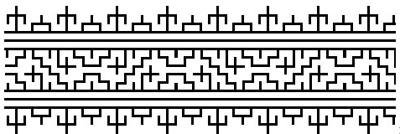If you’re into blackwork, or if you’re looking for some designs to get you started with blackwork embroidery, here’s a resource that might come in handy.

The above design comes from an online article by Heather Rose Jones called Medieval Egyptian Blackwork Embroidery. If you like blackwork and are intrigued by the geometric filling patterns often seen in this form of embroidery, you’ll find the article well worth your time!
What I especially like about the article is that the author analyzes the “work flow” of the pattern, showing the reader in what order the pattern would be stitched with the (reversible) Holbein stitch, also called reverse running stitch. The key point about Holbein stitch (named for the 16th century artist, Hans Holbein the Younger) is exactly that it is reversible – it looks the same, more or less, on both sides of the fabric. The tricky part of working any geometric design with Holbein stitch is figuring out how to follow the pattern so that the return journey of stitches works out. In her article, Heather Jones explains this well. She explains especially the anatomy of a wide band of blackwork, which she breaks down into two patterns in order to make the the piece work with Holbein stitch.
There are lots and lots of resources online for blackwork! But I really like this article by Heather Rose Jones, and I think it’s worth adding to your library. If you’ve got some favorite online blackwork resources, feel free to share them in the comment form below! I’m always looking for gems to add to my list, and I’m sure other readers will appreciate your input!
Enjoy your Sunday!







Thank you for one more precious link, Mary.
Surely it goes to my favourites about blackwork – a while ago I’m looking for useful links about blackwork – I want give it a try soon and found this link useful for me (i’ve never tried blackwork)
http://www.embroiderersguild.com/stitch/projects/blackwork/index.html and here some free patterns
http://sites.google.com/site/wyrdbyrdsnest/ maybe you already know them.
And thanks for your words but I’m not having fun knitting…whenever I knit something the next two or thee years I’ll knit nothing. I’m already missing my embroidery threads and now I’m trying something knew for me. I’ll give news soon I hope 🙂
Have a great Sunday!
http://www.blackworkarchives.com
I love the look of blackwork, but figuring out the stops and starts seems daunting to me so I’ve not done much of it at all.
I’m going to bookmark Heather’s link to peruse after I’ve finished my Move of Doom.
http://www.needlepointers.com/ShowArticles.aspx?NavID=377
Egyptian Blackwork is my current favorite of all the counted work styles. I discovered it when researching other kinds of historical counted work when I picked up a copy of Embroideries and Samplers form Islamic Egypt by Marianne Ellis. The pictures are wonderfully clear and its only a short step to transcribing them into patterns. I have just finished covering an entire Egyptian gown with this type of work that you can see posted on my website along with many other pieces I’ve done in this technique. And yes, that article by Heather Rose Jones is an excellent tutorial. Thanks for posting about this, its a field not many people know about.
Thank you so much for the review of my article — I’m delighted to know that people find it helpful! Sometimes I tend to over-analyze techniques, so I enjoy discovering that it’s a level of detail that people find helpful.
Heather Rose, I enjoyed your website!! Thanks for sharing so much of yourself.
Your playing the harp totally intrigues me . . . alas, a love of mine never to be fulfilled.
My question about blackwork (and thank you very much for your detailed charts!) is: does it have to be reversible? (or is that the challenge of the craft!)
Thank you!
Thanks for the great link Mary…when I do blackwork, if there are no detailed instructions, I just wing it. This illustrates ways to plan your needle trips.Great info!
I love Blackwork but haven’t tried it yet. I looked at the article by Heather Jones. On the examples that she showed on a grid, the stitches don’t go from corner to corner of the grid; they go in the middle of the box. If I were copying the motif on grid paper, I think I would want to go from corner to corner using the middle of the grid if a stitch was to be half as large as the others. Where is the mistake in my thinking? Thanks, Lora